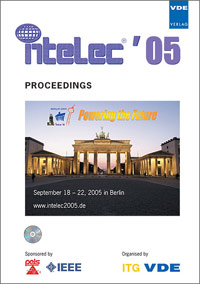Outdoor Enclosure Building Practice
Conference: Intelec '05 - Telecommunications Conference - 27th International Telecommunication Energy Conference
09/18/2005 - 09/22/2005 at Berlin, Germany
Proceedings: Intelec '05 - Telecommunications Conference
Pages: 5Language: englishTyp: PDF
Personal VDE Members are entitled to a 10% discount on this title
Authors:
Lindgren, Magnus; Ohlson, Ingemar (Ericsson AB, Sweden)
Kemppainen, Ari (Emerson Network Power, Sweden)
Abstract:
As the telecommunication networks are expanding with a large number of applications that require a flexible location, the use of outdoor enclosures is growing rapidly. These enclosures are often designed to meet specifications covering a wide range as regards applications, ambient conditions and also internal heat load. Many times, the main focus in the design process is to meet the application requirements, while external factors come second. To get large-scale economy for network roll out projects, the outdoor enclosure has standardized size and features. While this approach reduces the number of variants, it causes inflexibility for the service provider. The advantage is lower investment costs through high-volume production and lower maintenance costs through uniformity. The drawbacks are obvious, long lead-time for design, early commitment for a specific technical solution, few degrees of freedom of choice, small or no possibility to change size or footprint from a user point of view. If the operator needs more equipment on the site, the only way to meet that is by additional equipment enclosures. The issues of cost and lead time for roll out of customer specific, tailor made, outdoor enclosure plays a central part in the present work - a flexible cost-efficient and low environmental-impact approach for protection of outdoor located electronic equipment enclosures. In a perfect world, the enclosure design allows the operator to choose outdoor enclosure size and features depending on application and site requirements. The site should be tailor made without extra costs for flexibility. This requires an enclosure building practice with a dimensional flexibility but also flexibility to deploy backup systems, thermal control and other auxiliary equipment on the site. Once you, as a power system supplier, have accepted these requirements, you also have to meet short lead-time for customer evaluation prototypes and serial production units, all at a competitive pricing, while the system must meet the customer’s expectation regarding reliability and durability. The complete customer solution, including size-flexible enclosure, the right dc power system, control, backup and thermal system must be easily configured according to customer requirements. In this building practice, that configuration will automatically result in a production BOM, without passing through the engineering department, and so we will save time.


